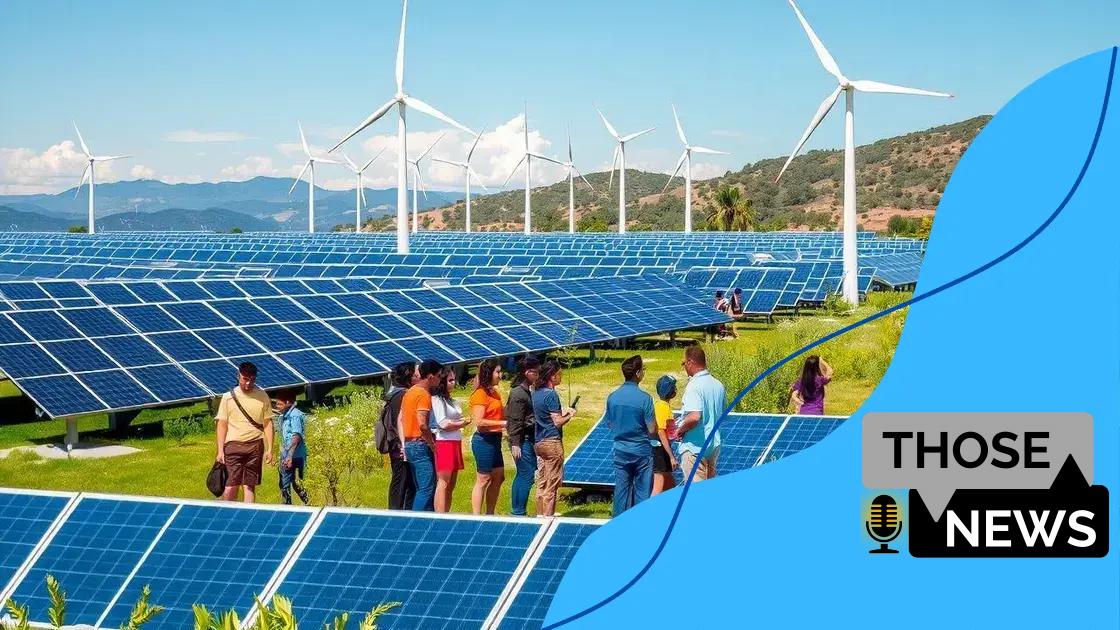Green energy adoption in emerging markets: a path to sustainability

Green energy adoption in emerging markets is essential for sustainable growth, overcoming financial constraints and infrastructure challenges through innovations like solar, wind technologies, and supportive policies.
Green energy adoption in emerging markets is transforming economies and communities across the globe. Have you considered how this shift might impact your daily life or business opportunities? Let’s dive into how these markets are embracing sustainable energy solutions.
Understanding green energy: definitions and types
Understanding green energy is crucial for appreciating its role in our lives and the benefits it offers. Green energy comes from natural sources that replenish themselves, making it a sustainable alternative to traditional energy sources.
There are several types of green energy that are commonly explored:
Common Types of Green Energy
Some of the main sources include:
- Solar energy: Harnessed from the sun, this type utilizes solar panels to convert sunlight into electricity.
- Wind energy: Generated through wind turbines, this energy source captures the power of wind to produce electricity.
- Hydropower: This involves using water flow, typically from rivers or dams, to generate energy.
- Geothermal energy: Derived from the Earth’s internal heat, it can be used directly for heating or to generate electricity.
These sources contribute significantly to reducing greenhouse gas emissions. Not only do they support environmental betterment, but they also promote economic growth in emerging markets. As countries invest in more sustainable technologies, they create jobs and reduce dependency on fossil fuels.
For instance, many developing nations are now focusing on building solar farms. This is an effective way to harness green energy and offer affordable electricity to communities. As technology advances, methods of implementing these energy solutions become more efficient and accessible.
By integrating green energy solutions, emerging markets can significantly improve their energy security while also combating climate change. The transition to these renewable resources opens up numerous opportunities for innovation and sustainability.
Current trends in green energy adoption
Current trends in green energy adoption highlight a significant shift in how societies view and utilize energy sources. As awareness of climate change grows, many countries are stepping up their efforts to integrate sustainable energy solutions.
One major trend is the increasing use of renewable energy technologies. Solar and wind power are leading the way, as both are becoming more efficient and less expensive. This transformation is making it possible for people and businesses to invest in green energy alternatives.
Key Trends Impacting Green Energy
Several key trends are shaping the future of green energy adoption:
- Government incentives: Many governments are offering tax credits and subsidies to encourage the use of renewable energy.
- Corporate commitments: Businesses are pledging to reduce their carbon footprints by investing in green technologies.
- Technological advancements: Innovations in energy storage and grid management are making renewable energy more viable.
- Public awareness: Increased education about climate change is leading more people to support and demand sustainable energy solutions.
Emerging markets are also playing a crucial role in this transition. Countries in regions like Africa and Asia are skipping traditional energy models and directly adopting renewables. This leapfrogging can create unique opportunities for growth and development.
Additionally, many communities are rallying around local renewable energy projects. These initiatives help boost local economies and empower citizens by giving them greater control over power generation. As more people embrace local solutions, the global movement toward green energy gains momentum.
The ongoing transition is not just an environmental imperative but also an economic opportunity. By investing in clean energy, nations can create jobs and stimulate growth. The current trends indicate a hopeful trajectory toward a more sustainable future.
Challenges faced by emerging markets

Emerging markets face numerous challenges when it comes to adopting green energy. These obstacles can hinder progress and slow down the implementation of sustainable practices.
One of the primary challenges is financial constraints. Many emerging economies struggle with limited funds for investing in new technologies. This lack of investment can delay the transition to renewable energy while maintaining reliance on fossil fuels.
Key Challenges in Green Energy Adoption
Among the challenges faced, some of the most notable include:
- Lack of infrastructure: Many countries do not have the necessary infrastructure to support green energy systems, making it difficult to generate and distribute renewable energy.
- Policy and regulatory issues: Unclear or inconsistent policies can create uncertainty for investors, making it tougher for emerging markets to attract funding.
- Technical expertise: Emerging regions often lack the skilled workforce needed to develop and maintain renewable energy technologies, resulting in external dependency.
- Public awareness: Limited knowledge about the benefits of green energy among the public can slow down the acceptance and adoption of renewable solutions.
Additionally, political instability can pose a significant risk. Uncertain governance can scare off potential investors, further limiting the resources available for green projects.
Emerging markets also deal with fluctuating energy demands. As economies grow, keeping up with energy needs while implementing sustainable practices can be challenging. The reliance on traditional energy sources may continue to dominate as countries attempt to balance growth with environmental considerations.
Nevertheless, many emerging markets are finding innovative ways to overcome these challenges. Through partnerships with international organizations and governments, they can secure funding and technical assistance to help boost the transition to a more sustainable energy future.
Success stories of green energy integration
Success stories of green energy integration inspire and demonstrate the potential of renewable energy in transforming communities and economies. Many countries have successfully paved the way for a sustainable future through innovative projects.
One notable example is the implementation of solar energy in Germany. The country has heavily invested in photovoltaic systems, making it a leader in solar power generation. This commitment has led to clean energy producing a significant portion of the nation’s electricity, while also creating numerous jobs in the renewable sector.
Examples of Successful Integration
Several other success stories illustrate the benefits of adopting renewable energy:
- Denmark’s Wind Energy: Denmark generates roughly 47% of its electricity from wind power. This achievement has positioned the country as a global leader in wind technology, fostering innovation and sustainability.
- India’s Solar Push: India has launched ambitious solar energy programs, aiming to generate 100 GW of solar power by 2022. This initiative has attracted investments and led to vast solar farms across the nation.
- Costa Rica’s Renewable Strategy: Costa Rica runs on over 99% renewable energy. Its strategy includes hydropower and wind energy, resulting in a commitment to sustainability and conservation.
- California’s Clean Power Plan: California is at the forefront of clean energy in the U.S., targeting 100% carbon-free electricity by 2045 while creating many jobs in the growing green economy.
These examples show how integrating green energy can significantly impact daily life and the economy. Communities benefit from enhanced energy security and reduced emissions.
As emerging markets observe these successes, they can learn valuable lessons about policy frameworks, technology adoption, and community engagement in renewable energy projects. Not only do these success stories encourage others to make the transition, but they also highlight the universal need for sustainable energy solutions.
Future prospects and innovations in green energy
The future prospects and innovations in green energy are shaping the way we think about energy production and consumption. With the urgency of climate change, new technologies are emerging to make renewable energy more efficient and accessible.
One exciting development is the advancement in solar technology. Innovations such as solar panels with higher efficiency ratings and lower production costs make solar energy even more attractive. This allows more households and businesses to harness the power of the sun.
Innovative Technologies Driving Change
Several cutting-edge technologies are paving the way for the future of green energy:
- Energy storage solutions: Battery technology continues to improve, allowing for better storage of energy produced from renewable sources. This ensures that energy is available even when the sun isn’t shining or the wind isn’t blowing.
- Smart grids: These high-tech grids can optimize energy distribution and manage demand more efficiently. With real-time data, smart grids help integrate more renewable energy sources into existing infrastructures.
- Hydrogen fuel cells: Hydrogen is gaining attention as a clean source of energy. Fuel cells can convert hydrogen into electricity with zero emissions, making it a potential game-changer for transportation and power generation.
- Waste-to-energy technologies: Innovations in converting waste materials into usable energy not only reduce landfill use but also provide an additional source of clean energy.
Countries are also focusing on policy frameworks that will encourage green energy development. By setting ambitious targets for renewable energy adoption, governments can drive innovation and attract investment.
Emerging markets are expected to play a significant role in this transition. They can leapfrog traditional fossil fuel systems by adopting renewable technologies directly. This approach not only provides cleaner energy solutions but also promotes economic development and job creation.
As we look ahead, the combination of innovative technologies and supportive policies will help to transform the global energy landscape. A shift towards green energy can lead to a sustainable future for our planet, benefiting both current and future generations.
In conclusion, the growth of green energy adoption represents a significant opportunity for both emerging and developed markets. The challenges faced are substantial, but they can be overcome with innovative solutions and supportive policies. As we move towards a more sustainable future, investing in renewable energy will benefit not only the environment but also economies around the world. By learning from success stories, countries can accelerate their transition to cleaner energy sources and ensure a better tomorrow for generations to come.
FAQ – Frequently Asked Questions about Green Energy Adoption
What are the main benefits of adopting green energy?
Adopting green energy can reduce carbon emissions, provide energy independence, and create jobs in the renewable sector.
What challenges do emerging markets face in green energy adoption?
Emerging markets often encounter financial constraints, lack of infrastructure, and policy issues that hinder their transition to renewable energy.
What innovations are driving the future of green energy?
Innovations such as energy storage solutions, smarter grids, and hydrogen fuel cells are enhancing the efficiency and viability of green energy.
Can you cite some success stories in the field of green energy?
Countries like Germany and Denmark have successfully integrated wind and solar energy, leading to significant emissions reductions and economic growth.

